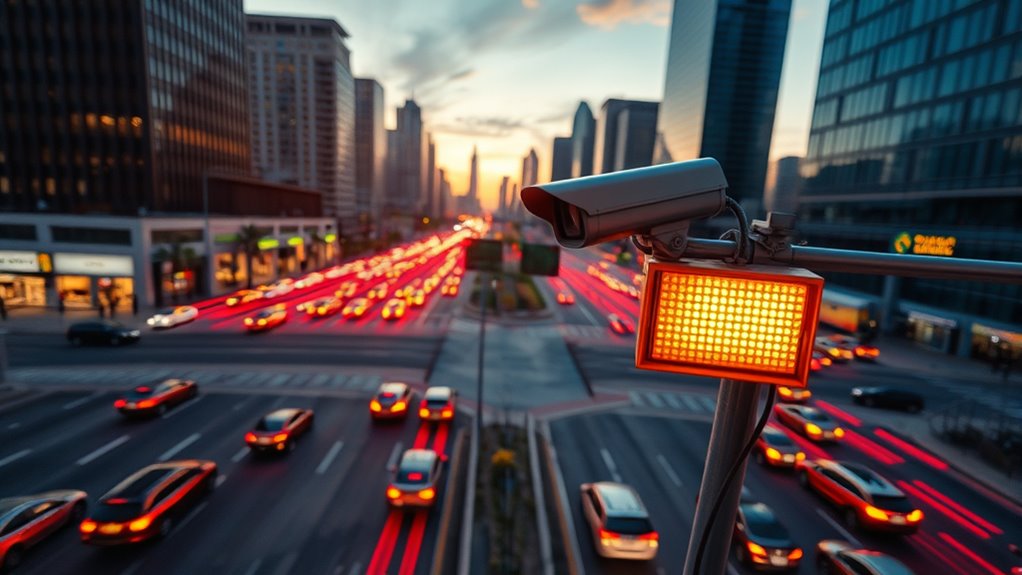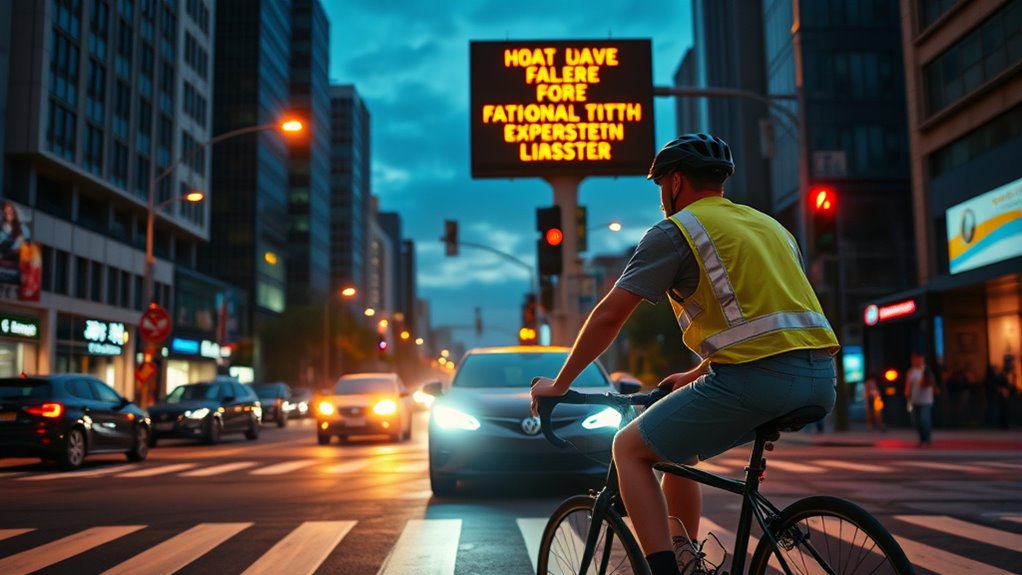Advanced alerting systems, like GPS navigation apps and vehicle safety features, warn you instantly of traffic hazards, accidents, and hazardous conditions ahead. These real-time alerts help you adjust your route and avoid dangerous situations before they happen. Roadside message boards and community alerts also keep you informed about local hazards. Staying proactive with these technologies reduces accident risks and keeps your drive safe. Continue exploring to discover how these tools can protect you even further.
Key Takeaways
- Real-time GPS navigation apps warn drivers about accidents and hazards ahead, enabling proactive route adjustments.
- Vehicle safety systems detect threats like lane departure or collisions, alerting drivers instantly to prevent accidents.
- Electronic message boards provide immediate updates on road closures, weather conditions, and hazards for safer driving decisions.
- Community alert systems notify drivers about local incidents, enabling timely route changes to avoid dangers.
- Timely alerts from roadside and traffic management systems help drivers react quickly, preventing traffic disasters.

Traffic accidents can happen in an instant, but timely alerts can be your best defense. When you’re behind the wheel, every second counts, and having real-time information about road conditions, hazards, or incidents can mean the difference between safety and disaster. Modern technology offers a variety of alerting systems designed to keep you informed and prepared, helping you react swiftly to potential dangers before they escalate.
One of the most effective tools for alerting you about traffic issues is GPS-based navigation apps. These apps continuously monitor traffic flow and update you about accidents, construction zones, or sudden slowdowns ahead. With these alerts, you can choose alternative routes, saving you time and avoiding dangerous situations. When an app warns you about a hazard, you can slow down, change lanes, or take a different path, reducing the risk of collisions or getting caught in gridlock.
GPS apps alert you to traffic issues, helping you find safer, faster routes before hazards become emergencies.
Vehicle safety systems also play a vital role in alerting you to imminent dangers. Features like collision warning systems, lane departure alerts, and blind-spot detection actively monitor your surroundings. They use sensors and cameras to detect other vehicles, pedestrians, or obstacles that might be out of your line of sight. When a threat is detected, these systems issue visual or auditory alerts, prompting you to take corrective action immediately. This proactive approach can prevent accidents caused by distracted or drowsy driving, as well as sudden maneuvers by other drivers.
Additionally, roadside warning signs and traffic management systems are designed to alert drivers of upcoming hazards. Electronic message boards can display real-time warnings about accidents, weather conditions, or road closures. These systems are especially valuable in adverse weather or during peak traffic hours when conditions can change rapidly. By paying attention to these alerts, you stay ahead of potential dangers and can adjust your driving accordingly.
Personal safety devices, such as roadside emergency alerts or push notifications from traffic authorities, further enhance your safety. These alerts can notify you about critical incidents in your area, helping you make informed decisions about your route or timing. Many cities also offer community-based alert systems where drivers can report hazards, contributing to a safer driving environment for everyone. In fact, understanding city-specific alert systems and local resources can significantly improve your response times and safety during emergencies.
Frequently Asked Questions
How Reliable Are Traffic Alerting Systems During Severe Weather?
Traffic alerting systems are generally dependable during severe weather, but their effectiveness can vary. Heavy rain, snow, or fog might disrupt GPS signals or delay updates, so you shouldn’t solely rely on them. Always stay alert, listen to local traffic reports, and adjust your driving accordingly. Combining technology with cautious driving ensures you stay safe, even when weather conditions challenge traffic alerts’ accuracy.
Can Alerts Be Customized for Specific Routes or Times?
Yes, alerts can be customized for specific routes or times. For example, you might set notifications for your daily commute from 7:30 to 8:30 a.m. on Highway 101. This way, you receive relevant updates only when you need them, reducing unnecessary distractions. Most traffic apps allow you to personalize alerts easily, so you stay informed about delays or accidents on your preferred routes during your preferred times.
What Privacy Concerns Are Associated With Traffic Alert Apps?
You might worry that traffic alert apps could compromise your privacy by tracking your location constantly or sharing your data with third parties. While many apps claim to protect your information, there’s always a risk that sensitive details could be exposed or misused. Be cautious and review privacy policies, disable unnecessary tracking features, and choose apps that prioritize user confidentiality to minimize these concerns.
Do Traffic Alerts Notify About Ongoing Accidents or Just Expected Delays?
Traffic alerts notify you about both ongoing accidents and expected delays. When an accident occurs, your app can send real-time notifications, helping you avoid the scene or choose an alternate route. Additionally, it predicts delays based on current traffic patterns, so you can plan ahead. Staying updated with these alerts allows you to make smarter driving decisions, save time, and avoid stressful traffic jams.
How Quickly Do Alerting Systems Update After Traffic Changes Occur?
Traffic alerting systems update almost instantly, detecting changes, processing data, and sending notifications in real-time. As soon as an incident occurs, sensors and cameras relay information to control centers, which then analyze and broadcast updates to your device. You receive timely alerts about accidents, congestion, or road closures, giving you the chance to reroute, avoid delays, and stay safe on your journey without missing a beat.
Conclusion
Remember, a stitch in time saves nine. Staying alert and paying attention to traffic alerts can prevent accidents before they happen. Don’t ignore warning signs or dismiss your instincts—your safety depends on it. By taking quick action and staying aware, you’re more likely to arrive safely at your destination. Keep your eyes on the road and your mind sharp; it’s better to be safe than sorry. After all, prevention is always better than cure.







